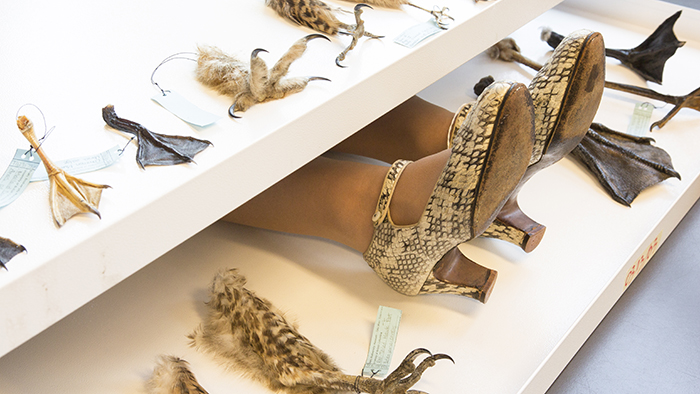
Skin & Bones by Catherine M. Stewart with Accessories from the Clothing Collections of Claus Jahnke & Ivan Sayers
September 15, 2018 – August 13, 2019
Examine our complicated relationship with the animal world in an exhibition that intersects the disciplines of natural science, fine art, and the applied art of fashion design.
Artist Statement
“His greatest desire was to know the difference between himself and the beast, and occasionally he became so absorbed in observing it that he truly believed he had sensed for a moment the nature of the creature’s existence.” Anton Reiser: A Psychological Novel by Karl Philipp Moritz: trans. by J.R. Russell
My approach for the Skin & Bones project was to try to capture some of the haunting beauty of the museum specimens, to ‘touch’ the animal within us and, in so doing, shift our perception of nature and our connection to it. The inclusion of display cases of historical animal-sourced fashion accessories provides yet another link between non-human species and ourselves. My hope is that this exhibition will encourage reflection and discourse about our morally complicated relationship with the natural world and foster a more nuanced and balanced understanding of our collective responsibility for maintaining what remains of it. – Catherine M. Stewart
 Originally from Windsor, Ontario, Catherine M. Stewart earned a BSc from the University of Toronto and a MFA from the University of British Columbia. Her recent artistic investigations relate visually and philosophically to the practices, aesthetics and history of science. Venues for solo exhibitions include the Isaac Newton Institute for Mathematical Sciences (2002), the Glasgow Science Centre (2004), and Murray Edwards College, University of Cambridge, UK in conjunction with the Darwin Festival (2009). Catherine’s last collaborative project with Ivan and Claus was the Invoking Venus: Feathers and Fashion exhibition at the Beaty Biodiversity Museum in 2013.
Originally from Windsor, Ontario, Catherine M. Stewart earned a BSc from the University of Toronto and a MFA from the University of British Columbia. Her recent artistic investigations relate visually and philosophically to the practices, aesthetics and history of science. Venues for solo exhibitions include the Isaac Newton Institute for Mathematical Sciences (2002), the Glasgow Science Centre (2004), and Murray Edwards College, University of Cambridge, UK in conjunction with the Darwin Festival (2009). Catherine’s last collaborative project with Ivan and Claus was the Invoking Venus: Feathers and Fashion exhibition at the Beaty Biodiversity Museum in 2013.
Claus Jahnke was born in Edmonton, Alberta and studied fashion merchandising in Vancouver, graduating in 1982. He has collected historic clothing since he was a young man, specializing in fashionable, occupational, and recreational costume made in Germany and Austria from 1732 to the 1960s. Items from his collection have been shown at various museums, including the Museum of Vancouver, the Royal Ontario Museum in Toronto, and the Fashion Institute of Technology in New York. His most important exhibition to date, hosted by the Vancouver Holocaust Education Centre, was called Broken Threads and illustrated the destruction of the Jewish garment industry in Germany and Austria under fascism.
Ivan Sayers was born in Cornwall, Ontario, and moved to British Columbia at the age of two. He graduated from UBC with a degree in Classical Studies and began his museum career as a volunteer at the Museum of Vancouver, where he eventually served as Curator of History from 1976 to 1990. Mr. Sayers has collected costume since he was a teenager and now has one of the finest privately-owned collections of period clothing in Canada. His collection of men’s, women’s, and children’s clothing and accessories dates from c. 1690 to the present. He has received awards from the BC Fashion Designers Association and was given a distinguished service award by the British Columbia Museums Association in 2010.
Exhibition Contributors
Curator
Yukiko Stranger-Galey
Scientific Curator
Chris Stinson
Designers
Derek Tan
Alirod Ameri
Fabricator
Lesha Koop
Scientific Advisors
Don Griffiths
Karen Needham
Ildiko Szabo
Rick Taylor
Education Advisor
Nancy Lee
Technical Support
Bill Boutin
Jeff Cowan
Jim Nasmith
Editorial Support
Jane Robinson-Bond
Other Contributors
Jeremy Butler
Cynthia Dinan-Mitchell
Diana Epperson
Georgia O’Neil
Michael O’Neil
Zocia O’Neil
Ruth Rigbey
Josh Robinson
Marina Robinson
Laura St. Amand
Halina Zalewska
Sponsored by ABC Photo
Beastly Habits: The Exploitation of Animals for Fashion in the 20th Century
September 21: Celebrate the opening of Skin & Bones with a fashion show under our blue whale.

